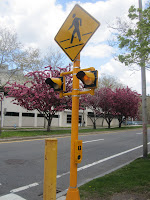At the intersection of Binney Street and 6th Street in Cambridge, MA there is a very popular pedestrian crosswal
 k. This crosswalk crosses Binney Street at the end of a pedestrian walkway, which connects Binney Street and Broadway. On the Broadway side of the pedestrian walkway is the Massachusetts Institute of Technology (MIT) campus, and on Broadway is a more residential area. The pedestrian walkway and crosswalk are both fairly busy as they are a main route connecting students to their classes from home.
k. This crosswalk crosses Binney Street at the end of a pedestrian walkway, which connects Binney Street and Broadway. On the Broadway side of the pedestrian walkway is the Massachusetts Institute of Technology (MIT) campus, and on Broadway is a more residential area. The pedestrian walkway and crosswalk are both fairly busy as they are a main route connecting students to their classes from home. The crosswalk features Zebra striping as well as a large refuge median in the center of the road. Also, there is a push-button activated flashing yellow signal to indicate pedestrians are crossing the road. The flashing yellow signals are on both sides of the road facing oncoming traffic, along with yellow signage indicating there is a crosswalk at this location.
The yellow signals are not active unless a pedestrian (or cyclist) pushes the button. The signal flashes for 20 seconds to allow the pedestrian to cross. By observing pedestrians, this time window was plenty for them to cross both directions of traffic without stopping on the refuge median. However, if the pedestrian can only ma
In addition to the flashing yellow signal, there are “sharks teeth”, 
The goal of this traffic calming method was to allow pedestrians a safe place to cross Binney Street and to also alert drivers that there may be pedestrians crossing. Overall, this goal is definitely being achieved. By observing drivers, it was seen that they slowed down even if there were no pedestrians in the crosswalk. By combining the shark’s teeth with the crosswalk signs, the point was made very clear that pedestrians could be present.
One downfall of this design is pedestrian awareness. Most pedestrians are accustomed to push buttons making traffic stop to allow them to cross. This is not the case at this crosswalk. Pedestrians may simply push the button and assume it is safe to cross and that the oncoming traffic will stop. While all drivers should stop for the pedestrians, it does not happen all the time. Pedestrians that are not aware of this may continue to walk across the street while cars are still moving.
The intended use for this design was for the pedestrians to push the button to 

"In an area with more traffic" -- remember that some times of day have more traffic than others. During peak hours, there's plenty of traffic.
ReplyDeleteIf a ped pushes the button on one side of the street, do yellow lights flash on both sides of the street, or only on the side where the ped is? If the latter, then pushing the button again in the median would be normal.
If there is no conflicting traffic, why should a ped bother to push the button? The fact that pushing a button and waiting isn't required makes ped delay very low.
Did stopping cars stop at the setback yield line, as intended?